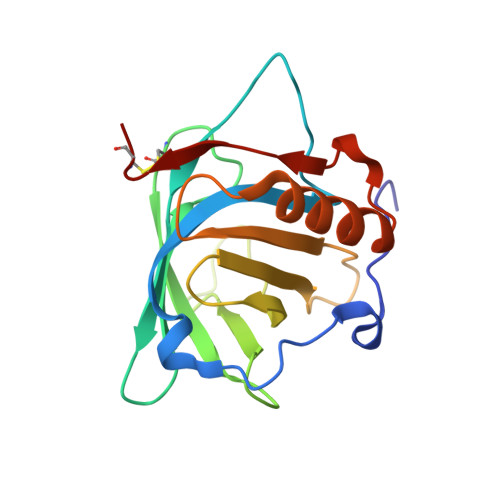An engineered lipocalin that tightly complexes the plant poison colchicine for use as antidote and in bioanalytical applications.
Barkovskiy, M., Ilyukhina, E., Dauner, M., Eichinger, A., Skerra, A.(2019) Biol Chem 400: 351-366
- PubMed: 30517073
- DOI: https://doi.org/10.1515/hsz-2018-0342
- Primary Citation of Related Structures:
5NKN - PubMed Abstract:
Colchicine is a toxic alkaloid prevalent in autumn crocus (Colchicum autumnale) that binds to tubulin and inhibits polymerization of microtubules. Using combinatorial and rational protein design, we have developed an artificial binding protein based on the human lipocalin 2 that binds colchicine with a dissociation constant of 120 pm, i.e. 10000-fold stronger than tubulin. Crystallographic analysis of the engineered lipocalin, dubbed Colchicalin, revealed major structural changes in the flexible loop region that forms the ligand pocket at the open end of the eight-stranded β-barrel, resulting in a lid-like structure over the deeply buried colchicine. A cis-peptide bond between residues Phe71 and Pro72 in loop #2 constitutes a peculiar feature and allows intimate contact with the tricyclic ligand. Using directed evolution, we achieved an extraordinary dissociation half-life of more than 9 h for the Colchicalin-colchicine complex. Together with the chemical robustness of colchicine and availability of activated derivatives, this also opens applications as a general-purpose affinity reagent, including facile quantification of colchicine in biological samples. Given that engineered lipocalins, also known as Anticalin® proteins, represent a class of clinically validated biopharmaceuticals, Colchicalin may offer a therapeutic antidote to scavenge colchicine and reverse its poisoning effect in situations of acute intoxication.
Organizational Affiliation:
Lehrstuhl für Biologische Chemie, Technische Universität München, 85354 Freising (Weihenstephan), Germany.















